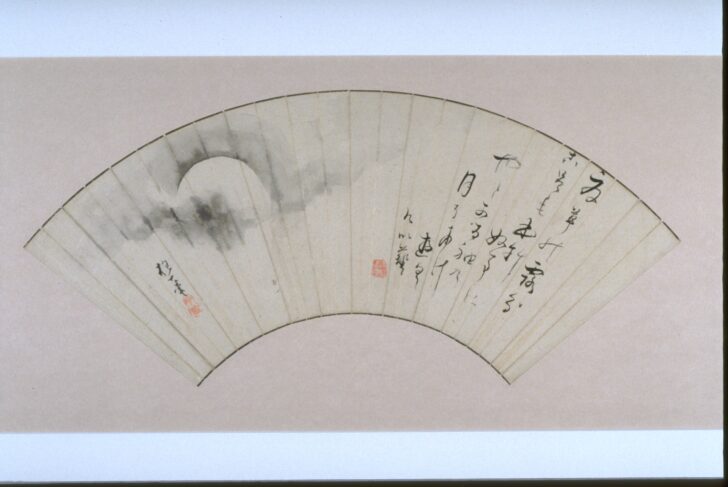Moonlight and calligraphy
Sakai Hōitsu

Description
Sakai Hōitsu’s painting is characterized by an interplay between text and image that underscores the emotional tenor of the poem, which is a reflection on the transience of a love affair:
Damp with the dew of summer grasses, my cloak
is barely dry before
my sleeves are wet with tears
in the moonlight of the dawning sky.*
“Sleeves wet with tears” is a conventional reference to the sorrow of parting from a lover. The poem thus narrates the complaint of a man who has made a secret visit (scrambling through the bushes, no less) to his paramour and finds that the night is over before his clothes have dried. Hōitsu’s wet ink washes matches well with the moist atmosphere of the poem. By juxtaposing a lighter wash to render the faint outline of a moon with the more vigorous brushwork seen to the right, the artist beautifully conjures the ups and downs of love.
*Adapted from a translation by Milan Mihal.
Subject Matter:
In Japan, moon-viewing is usually associated with autumn, but Hôitsu avoids that cliché in this image of a summer moon at dawn. This fan was probably painted to accompany the suggestive yet humorous poem inscribed on its surface in a cursive hand; it may be loosely translated as
Damp with the dew of summer grasses, my cloak
is barely dry before
my sleeves are wet with tears
in the moonlight of the dawning sky.
[Adapted from a translation by Milan Mihal.]
“Sleeves wet with tears” is a conventional reference to the sorrow of parting from a lover. The poem thus narrates the complaint of a man who has made a surreptitious night visit (scrambling through the bushes, no less) to visit his paramour but now finds that the night is over before his clothes have dried. Hôitsu’s wet ink washes well match the moist atmosphere of the poem.
Physical Description:
This is a painting of a fan. As for the details on the fan, on the left side, there is a drawing of the full moon partly hidden behind clouds. On the right side is writing in calligraphy. There is another line of calligraphy father to the left of the moon. Some of the writing is in red.
Usage Rights:
If you are interested in using an image for a publication, please visit https://umma.umich.edu/request-image/ for more information and to fill out the online Image Rights and Reproductions Request Form.